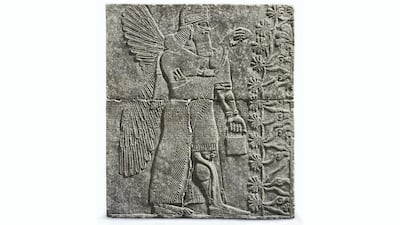A 3000-year-old Iraqi artefact goes on sale at Christie’s auction house in New York this week, where it is expected to fetch more than $10m for its American owners. However, the Iraqi government has demanded a halt to the sale of the two-metre frieze taken from an ancient Assyrian palace.
The carving of the “winged genius” is billed as the most exquisite piece of Assyrian art to reach the market in decades and is the centrepiece of Christie’s antiquities sale.
It was excavated in the middle of the 19th century from the ruins of the Northwest Palace in Nimrud, in what is present-day Iraq.
However, demonstrators are planning to congregate outside the sale room to demand its return.
A spokesman for Iraq’s ministry of culture said officials had contacted Interpol and Unesco, the United Nations cultural organisation, to stop the sale and repatriate the ancient artifact.
“We call on all Iraqi and international officials, civil society and the media to take a serious stand in pressuring the Americans in stopping this process, it is a continuation of the destruction of Iraq’s cultural heritage,” he said, adding that steps had been taken to prove that the artefact came from the ancient city of Nimrud.
Christie’s estimate values the gypsum carving of a god-like figure at as much as $15 million. That would set a world record for the sale of an Assyrian art work, which currently stands at a shade under $12 million.
The case is the latest controversy to hit the American antiquities market. Dealers, auctioneers and museums have all had items confiscated.
Earlier this year thousands of ancient artifacts looted from what is believed to be a lost Sumerian city were sent back to Iraq after being smuggled into the US as “ceramic tiles”.
And last year, prosecutors seized a plundered Persian artefact valued at $1.2m from a British dealer at an art fair in New York, a Roman marble torso of Cupid from Christie’s says before it was to be auctioned, and a 2,300-year-old bull’s head sculpture from the Metropolitan Museum of Art.
The rise of ISIS and the modern plunder of museums and archaeological sites flooded the black market with stolen artifacts.
However, the Christie’s piece left the region more than 150 years ago when modern day Iraq was part of the Ottoman empire.
A spokesperson for the auction house said the relief was excavated with permission of the Grand Vizier of the Ottoman Sultanate.
“While Christie’s is sensitive to claims for restitution by source countries of cultural property, there is a long-standing and legitimate market for the works of art of the ancient world which have been collected for centuries and have had a profound effect on the development of Western culture,” she said.
“That is clearly the case for this relief, and that is why Christie’s feels the sale of this piece is legitimate and safe.”
Jabbar Jaafar, executive director of Voices for Iraq, said the explanation was not good enough.
“In that time Iraq was under occupation,” he said.
Mr Jaafar called for supporters to protest outside Christie’s on Wednesday
“This is not just the heritage of Iraq. This is the heritage of mankind,” he said.
The carving was commissioned by Assyrian King Ashurnasirpal II whose reign spanned parts of modern-day Iraq and Syria from 883 to 859 BC. His palace was one of the largest in antiquity.

The ruins at Nimrud were excavated by a British archaeologist Sir Austen Henry Layard in the middle of the 19 th century. Many of his finds made their way to London, where they are now on display in the British museum.
But the pieces were also of intense interest to missionaries, who had read of the ancient Assyrian empire in the Old Testament. The discovery of Assyrian treasures was taken as proof that the Bible was a work of history rather than fiction.
Three pieces carved in gypsum were sold for $75 (including shipping to the US) to an American missionary and eventually ended up in a seminary near Washington, which provides postgraduate education to clergy of the Episcopal Church.
They were displayed in the library of the Virginia Theological Seminary, until a routine audit revealed the true value of the carvings, sending insurance premiums spiralling to $70,000 a year.
In a statement, it said the sale would help preserve the remaining two reliefs and fund a scholarship.
The relief shows an Akpallu, or demi-God, with finely feathered wings and a horned headdress. He holds a bucket and a cone to represent fertility and protection for the king.
Max Bernheimer, international head of antiquities at Christie’s in New York, said the scale of the carving was in keeping with the monumental size of the palace at Nimrud.
“These huge slabs of gypsum, sculpted in relief, were designed to impress and overwhelm,” he said. “Every aspect was related to the strength and power of the king.”
___________________
Read more:
UAE funds rebuilding of Mosul’s Al Nuri Mosque and historic minaret
Restoring Mosul's lost treasures one byte at a time
Revealed: The anonymous Mosul historian who leaked ISIS secrets
___________________

